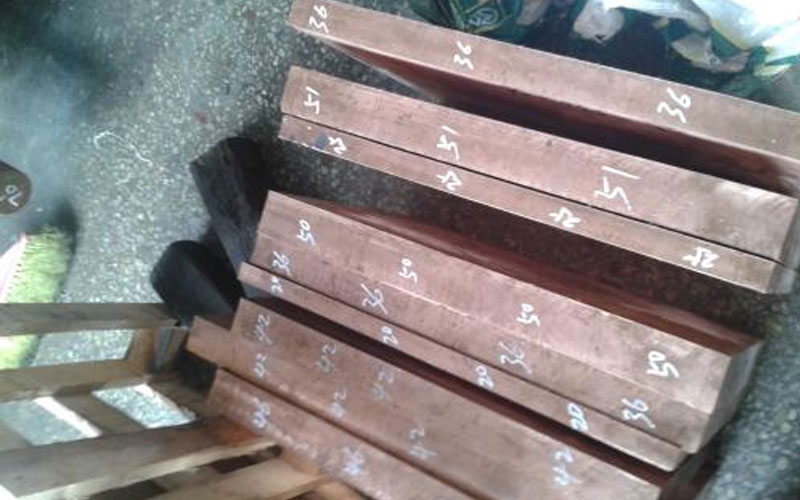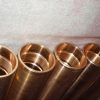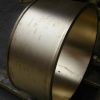
The heat treatment of Cu-Be alloy is mainly solution annealing and age hardening. Unlike other copper alloys where strength is obtained only by cold working, forged beryllium copper is obtained by cold working up to 1250 to 1500 Mpa and thermal age hardening. Age hardening is often referred to as precipitation hardening or heat treatment. The ability of beryllium copper alloys to accept this heat treatment is superior to other alloys in terms of forming and mechanical properties. For example, complex shapes can be achieved at the highest strength and hardness levels of other copper-based alloys, that is, during material rolling and subsequent aging. The following text details the age-hardening process for high-strength Cu-Be alloy C17200, and specific heat treatments for forged and cast alloys, recommended heat treatment equipment, surface oxidation and general solution heat treatment methods. ..
During age hardening, fine beryllium-rich particles form within the metal matrix. This is a diffusion-controlled reaction whose strength changes with aging time and temperature. The recommended standard times and temperatures allow parts to reach peak strength within 17200 to XNUMX hours without any loss of strength with prolonged exposure to temperature. For example, the CXNUMX alloy response curve in the figure shows how low temperature, normal temperature, and high aging temperature affect the peak performance of alloys and the time required to reach peak strength.

how-low-temperature,-normal-temperature,-and-high-aging-temperature-affect-the-peak-performance-of-alloys-and-the-time-required-to-reach-peak-strength
As can be seen, at temperatures as low as 550°F (290°C), the intensity of C17200 increases slowly and does not peak until after about 30 hours. At a standard temperature of 600°F (315°C) for 3 hours, the strength of C17200 changed little. At 700°F (370°C), the intensity peaks within 30 minutes and falls almost immediately. That is, as the aging temperature increases, both the time required to reach the peak intensity and the maximum available intensity decrease.
C17200 Beryllium Copper Can be aged with different strengths. Aging peak refers to aging up to maximum intensity. Alloys that have not been aged to the maximum strength will not age, alloys that have exceeded the maximum strength will age too much. Overaged Cu beryllium enhances toughness, uniform elongation and fatigue strength, while overaged enhances conductivity, thermal conductivity and dimensional stability. Beryllium copper does not age at room temperature even after long-term storage.
The tolerance for age hardening time depends on the furnace temperature and the final performance requirements. In order to reach the optimum elapsed time at standard temperature, the furnace time is generally controlled within ±30 minutes. However, high temperature aging requires more accurate timing to avoid averaging. For example, to maintain the best performance, the C17200 aging time at 700°F (370°C) should be controlled within ±3 minutes. Similarly, the rapid increase in the aging curve in the early stages requires tighter control of the process variables, even with poor aging. The heating and cooling rates are not critical for a standard age hardening cycle. However, to prevent parts from aging before reaching temperature, thermocouples can be placed to determine when the desired temperature is reached.
Age Hardening Device
Circulating air furnace. The temperature of the recirculation air oven is controlled at ±15°F (±10°C). Recommended for standard age hardening of copper beryllium parts. Designed for large and small volume parts, these furnaces are ideal for drum stamping parts on aging carriers. However, due to its pure thermal quality, the mass parts must not be underaged or the aging cycle is too short.
Chain aging furnace. Steel strand aging furnaces with a protective atmosphere as the heat transfer medium are usually suitable for processing large numbers of beryllium copper coils in long furnaces, allowing the material to expand or curl. This allows for better control of time and temperature, avoiding partial homogeneity and controlling special periods of inadequate or high temperature/short time aging and selective curing.
Salt bath. We also recommend using a salt bath for age hardening of beryllium copper alloys. Salt baths provide rapid and uniform heating and are recommended over all temperature cure ranges, especially during short periods of high temperature aging.
Vacuum furnace. Vacuum aging of copper-beryllium components works fine, but with caution. Since heating in a vacuum furnace depends only on radiation, it is difficult to uniformly heat heavy-load parts. The outer portion of the load is more directly exposed to radiation than the inner portion, so the temperature gradient after heat treatment will change performance. To ensure uniform heating, the load must be limited and the component must be isolated from the heating coil. Vacuum furnaces can also be used to backfill inert gases such as argon and nitrogen. Similarly, unless the furnace is equipped with a circulating fan, it is necessary to protect the parts.






